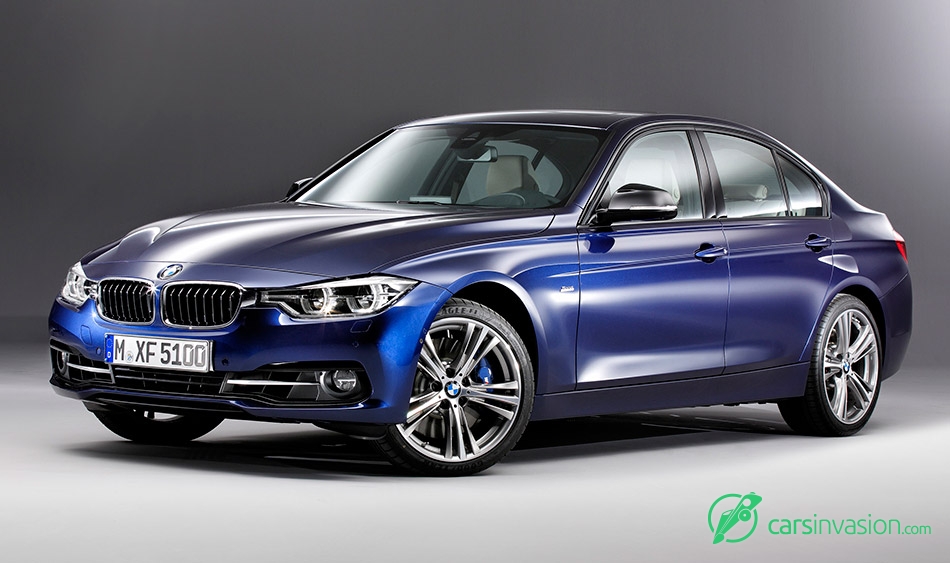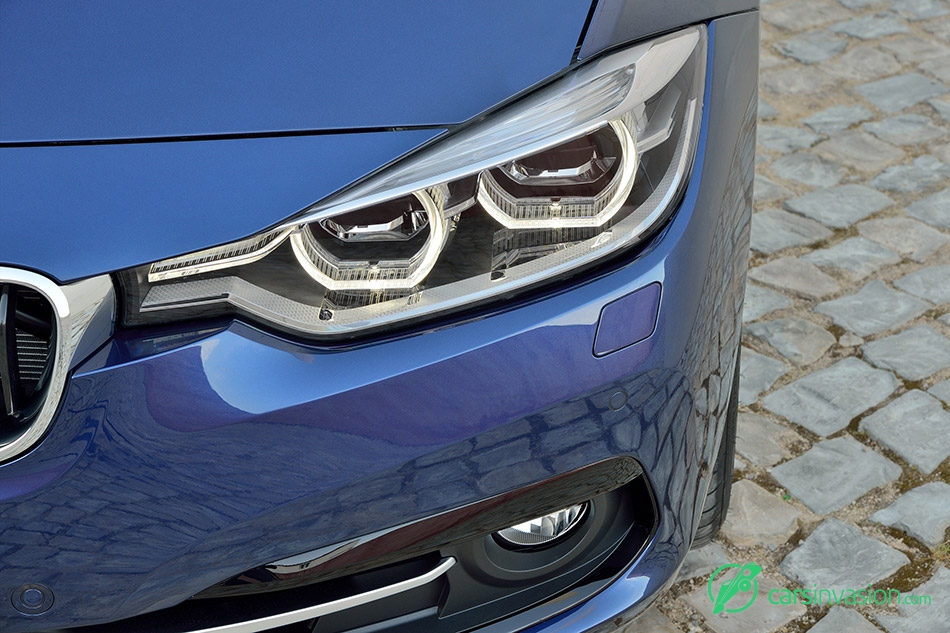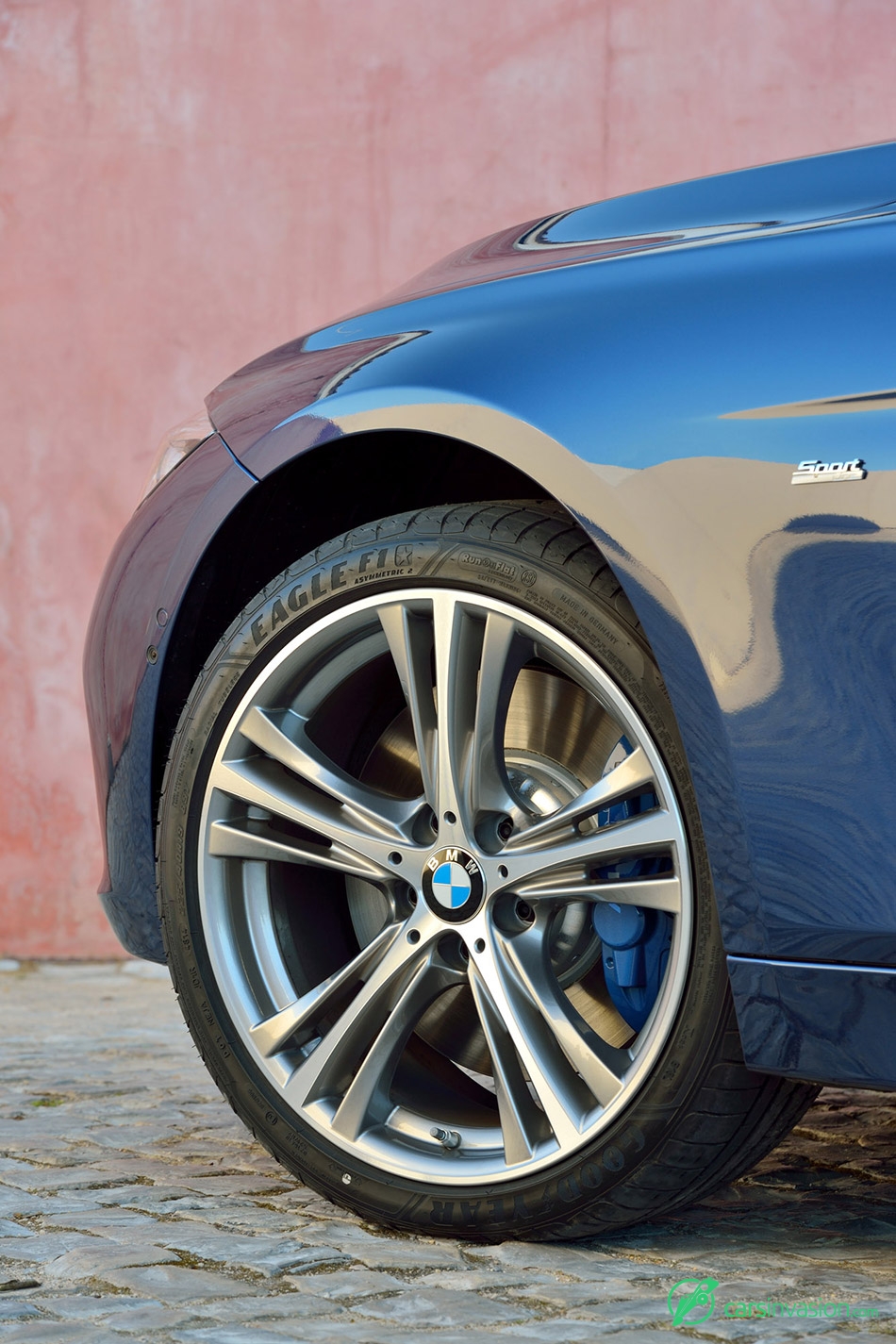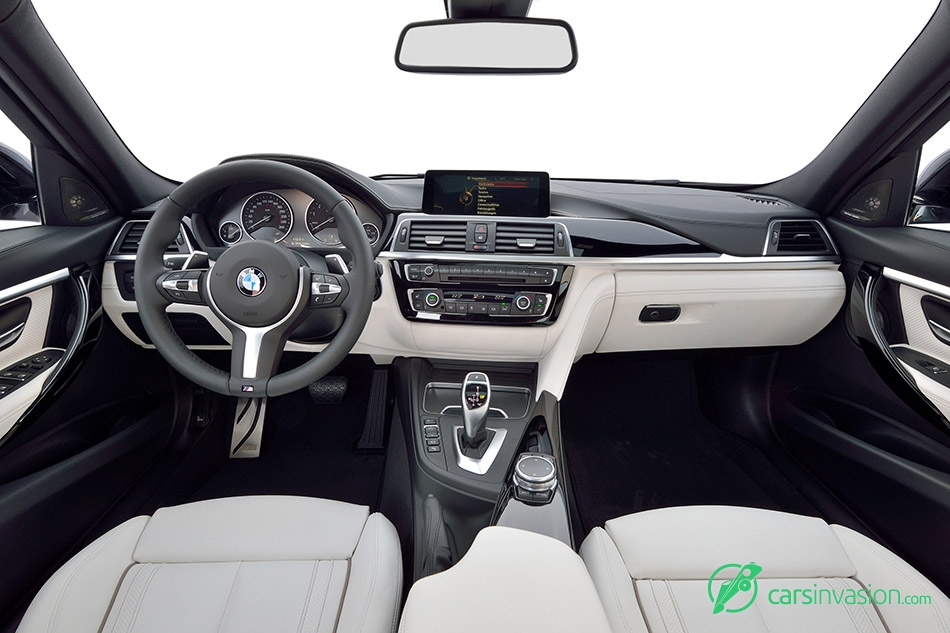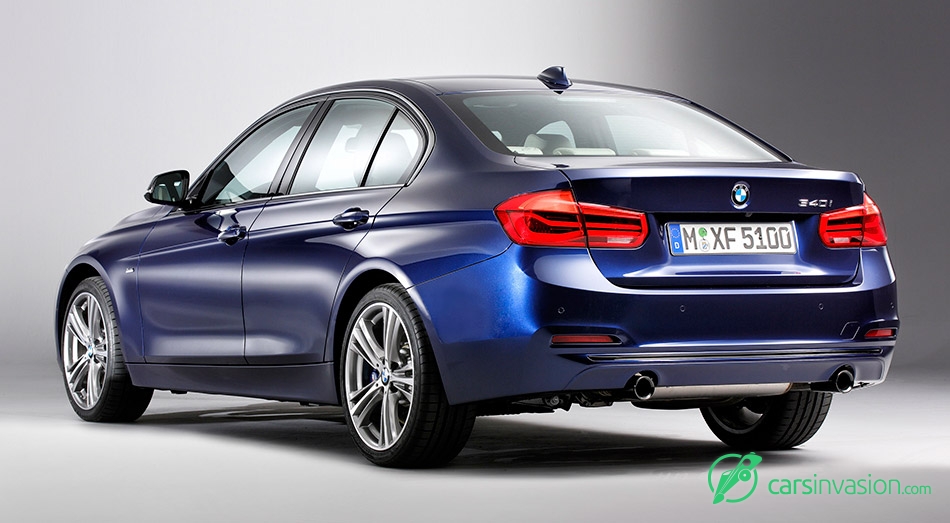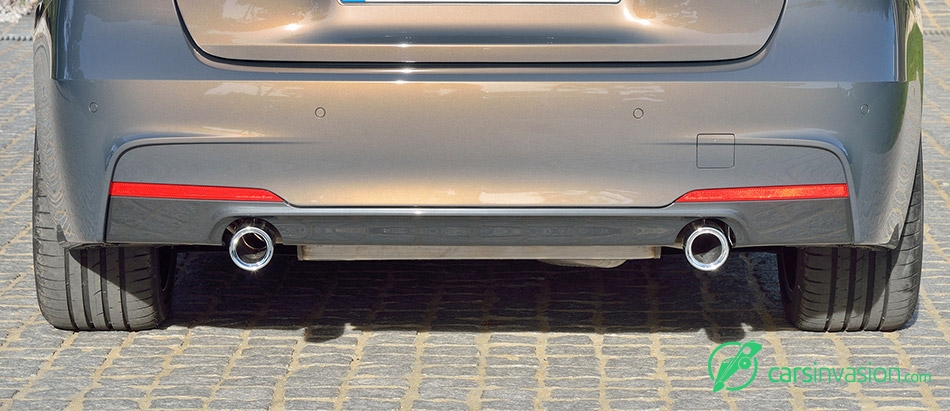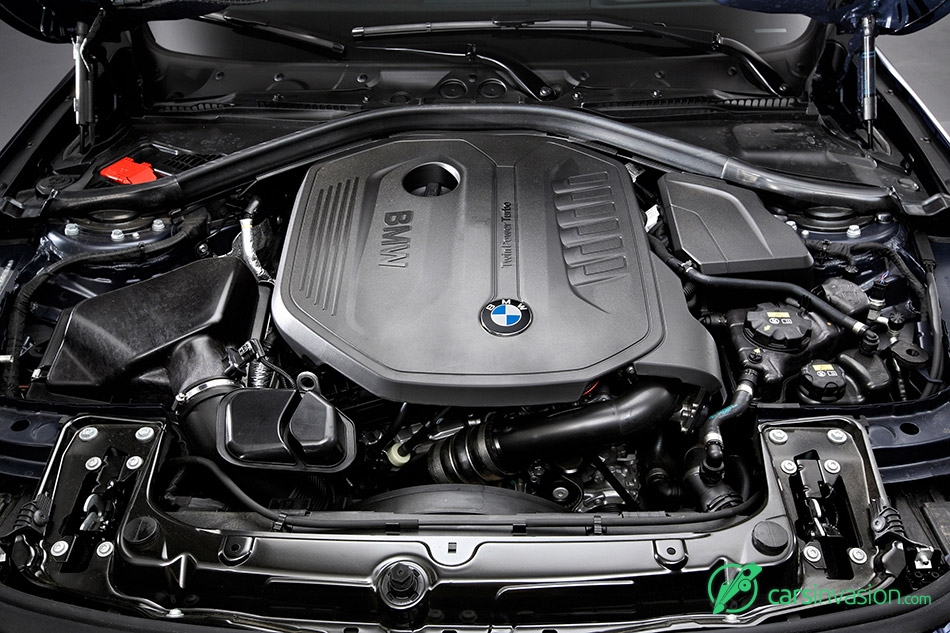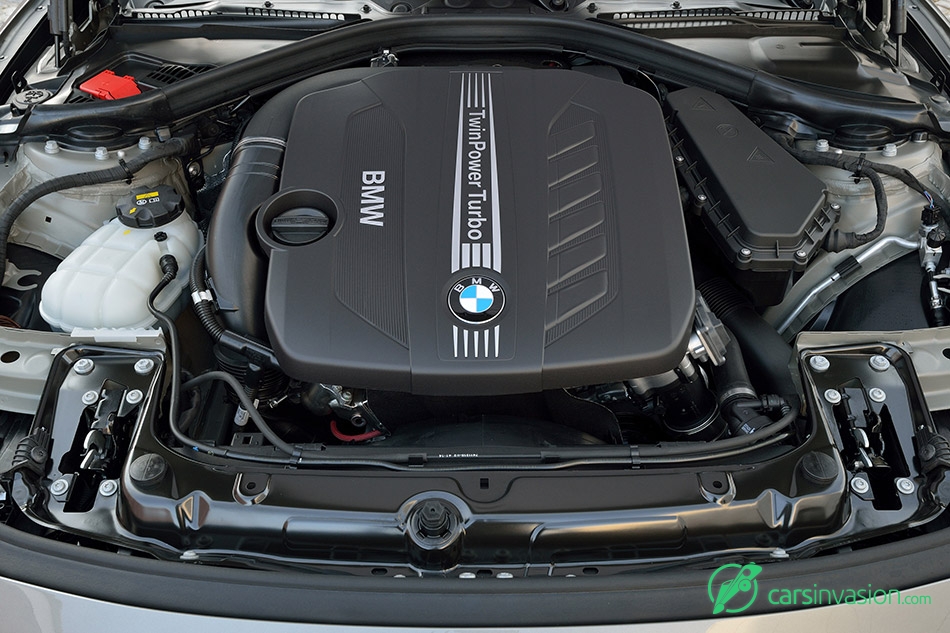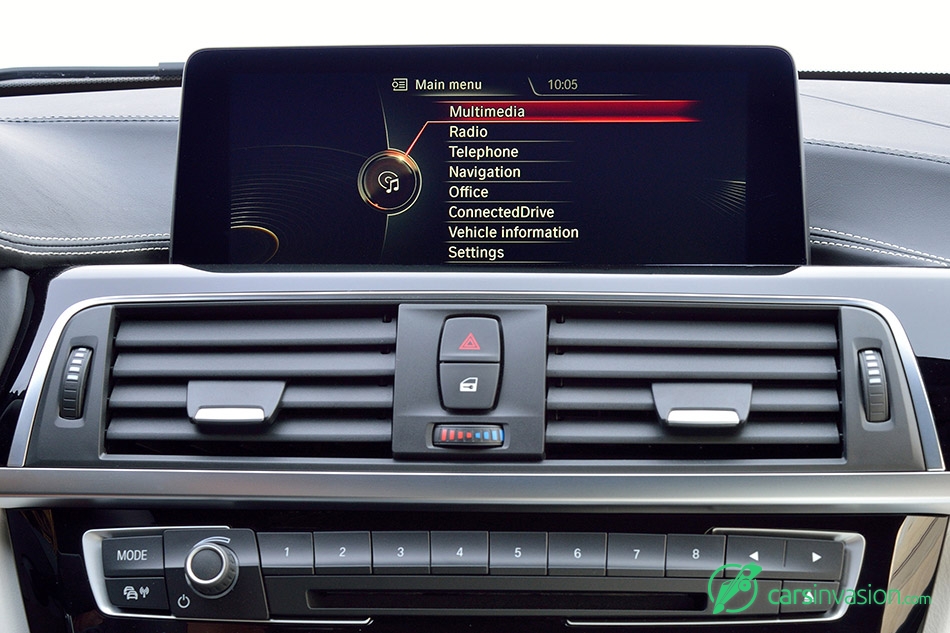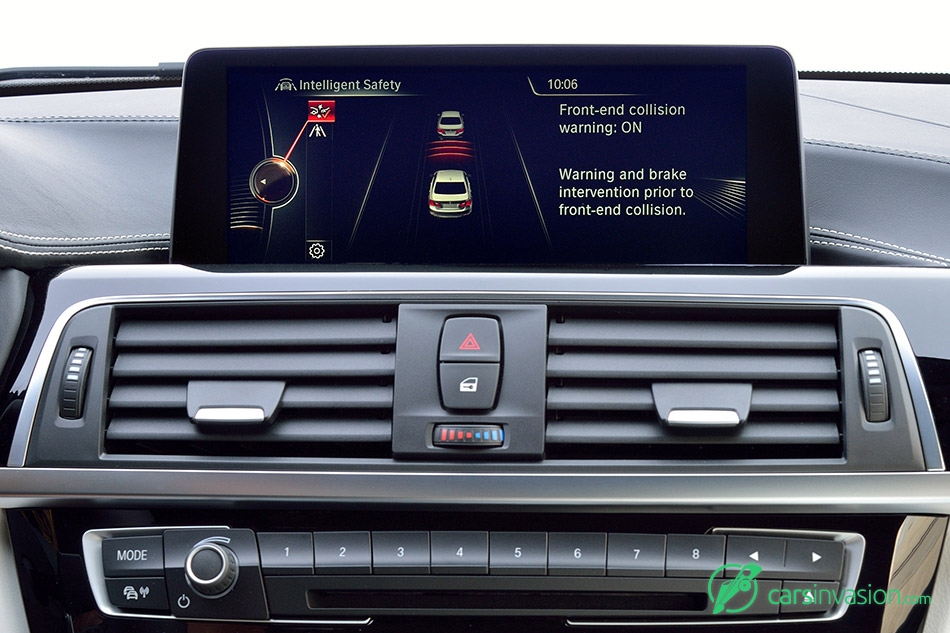The eye-catching looks of the new BMW 3-Series imbue it with a striking presence on the road. The distinctively sculpted long bonnet and set-back passenger compartment team up with the short front and rear overhangs and long wheelbase to create the extremely dynamic proportions that are as much a hallmark of BMW as ideal 50:50 weight distribution. Precisely designed headlights further emphasise the dynamic credentials of the BMW 3-Series, while the powerful rear end of the Sedan and Touring, complete with a clearly defined new lighting design, underlines their sporting appearance to excellent effect.
Individuality and personality
Revised headlights provide an even more vivid visual showcase for the dynamic flair of the new BMW 3-Series. LED indicators now positioned as "eyebrows" above the headlights and integrated in noticeably more horizontal form give the optional LED headlights a look of even greater concentration. In cars with standard specification, the headlights are joined by two LED daytime driving light units on each side. These light strips highlight the hallmark BMW twin headlight arrangement and create a stylistic link between the headlight units and the BMW kidney grille. They give the car a clear road presence in daylight, too, and ensure a strong recognition value both from a distance and in the dark.
Full-LED lights and BMW Selective Beam as an option
The new BMW 3-Series can be ordered as an option with full-LED headlights, which are even more efficient than the xenon headlights offered to date and accentuate the sharper gaze of the front end. In addition, the "eyes" of the BMW 3-Series have moved further apart, visually strengthening the car's broad stance on the road. The daytime driving lights are even more striking and precise thanks to the levelled off upper and lower edges of the LED light tubes. These also form a visual connection with the BMW kidney grille in the shape of an LED light bar. Another contributor to the technology leadership status of the new BMW 3-Series is the optional BMW Selective Beam system. The camera-based, anti-dazzle High Beam Assistant adjusts the car's lights dynamically using actuators to ensure the road is illuminated as well as possible without dazzling oncoming traffic and vehicles travelling ahead. This helps to maximise the use of the main beam and significantly widen the illuminated area in front of the car - further increasing driving pleasure, enhancing visibility and therefore improving safety at night.
New width-enhancing effect and stronger visual presence
Broader side air intakes in the front apron give the new BMW 3-Series Sedan and new BMW 3-Series Touring an even stronger stylistic presence. This powerful appearance is further underlined by the strikingly sculptural and precise form of the bumpers. The new, more intricate structure of the central air intake also allows the radar sensor for the Active Cruise Control (ACC) to be integrated more discreetly.
The rear end with its sporty design also impresses with its likewise highly sculptural, clearly defined lines. The newly designed rear lights are full-LED units. The light bars, arranged in a distinctive BMW "L" shape and now more heavily curved, lend greater dynamic presence to the rear end of the car even when it is stationary. Added to which, the integrated LED brake lights raise safety another notch thanks to their faster responses. The two-piece LED indicators form a horizontal band of light across both sections of the rear lights and provide extremely even and consistent light. They stretch into the boot lid (or the tailgate on the BMW 3-Series Touring) and underline the car's sporty looks. The wider, Line-specific trim element on the rear apron lends additional emphasis to this dynamic appearance. The Line badge on the car's front side panels is now more three-dimensional in design.
The top-of-the-line petrol engine in the BMW 340i comes with an exhaust system featuring individual 80-millimetre tailpipes on the left and right, while the engines for the 320i and 320d models upwards now come with twin tailpipes, each 70 millimetres in diameter. The tailpipe for the entry-level models measures 75 millimetres in diameter. The sporting appearance of the new BMW 3-Series is underlined visually and functionally by a new range of wheels. Rims up to 19 inches are available as an option, and the Original BMW Accessories range also includes 20-inch items.
High-quality interior, unimpeachable ergonomics
The interior faithfully reflects the dynamic and elegant lines of the sporty BMW 3-Series model range. The cockpit's driver focus is a signature BMW feature and provides optimum access to all the important functions. The outstanding ergonomics of the BMW 3-Series have been improved further still and additional, carefully arranged chrome highlights and high-gloss surfaces give the interior an even classier look.
The central control panel in the centre console comes in high-gloss black. If the interior lighting package is specified, it also features an ambient lighting surround and is imbued with an even greater feeling of quality by additional chrome applications. Chrome accents make the newly designed controls for the electric seat adjustment, for example, clearer to the eye. Moreover, their improved form and feel allow them to be used even more intuitively. Chrome applications are also a feature of the electric window controls and air vents, bringing added high-quality accents to the interior. In cars with the Luxury Line, Sport Line or M Sport package specified, the accent strip in the instrument panel continues expansively into all four doors, emphasising the generous levels of space for the passengers and providing a classy ambience. The cupholders in the centre console add another practical feature and now have a sliding cover. An additional practical storage area for items such as a smartphone is positioned forward of the cupholders.
Lines enable further individualisation
Offered as an alternative to standard specification and the Advantage option - which includes features such as Park Distance Control at the rear and Cruise Control with Braking function as standard - the Sport Line and Luxury Line equipment lines lend the new BMW 3-Series an individual character of their own, while the M Sport package offers additional options designed to further increase road presence and driving pleasure.
In addition to the new, optional Corner Anthracite cloth upholstery with accent colour, cars in standard specification can also be ordered with the Oyster colour variant for cloth/leather and leather seats and new 16-, 18- and 19-inch wheels as an option. The Sport Line and Luxury Line equipment lines and the M Sport package can now also be specified as an option with the "ash black" wood panel with metal inlay. Sport Line models offer new leather upholstery variants with accents in Veneto Beige and Saddle Brown. The same applies to cars with the Luxury Line, which can also be specified with new bi-colour 18- inch light-alloy wheels in multi-spoke design. Among the features of the M Sport package are the M aerodynamic package, an M leather steering wheel, M Sport suspension and front sports seats, the anthracite-coloured BMW Individual headliner and the Driving Experience Control switch with additional Sport+ mode. This seriously sporty equipment variant is also available with the new leather upholstery options with accents. Now available in addition to the exclusive 18- and 19-inch M light-alloy wheels is an 18-inch light-alloy wheel option in Orbit Grey.
Customers can choose from a total of 16 exterior colours for their new BMW 3-Series. New additions to the range include striking Mediterranean Blue metallic, Platinum Silver metallic and Jatoba metallic, in addition to the Individual colour Champagne Quartz metallic. The Estoril Blue metallic shade is still reserved exclusively for cars equipped with the M Sport package.
Honing the character of the BMW M3 as well
Reflecting the even more sharply defined, dynamic design and even higherquality interior introduced for the new BMW 3-Series model range, the BMW M3 now also gains newly designed full-LED rear lights and precise, quality-feel chrome highlights for the interior. The latest-generation Navigation system Professional with LTE - the fastest mobile standard currently available - is now also an option for the BMW M3, while two new BMW Individual exterior colour shades (Smoked Topaz metallic and Champagne Quartz metallic) can be specified for the new BMW M3 in addition to the exclusive Tanzanite Blue metallic and Azurite Schwarz metallic BMW Individual paint finishes.
Powertrain and chassis
The BMW 3-Series has symbolised driving enjoyment combined with frugal fuel consumption for the past 40 years. Now the new BMW 3-Series Sedan and the new BMW 3-Series Touring are raising the bar yet again. The engine range comprises a total of four petrol engines, with outputs ranging from 100 kW (136 hp) to 240 kW (326 hp), and seven diesel engines with outputs from 85 kW (116 hp) to 230 kW (313 hp) (combined fuel consumption: 7.9- 3.8 l/100 km [35.8-74.3 mpg imp]; combined CO2 emissions: 185-99 g/km). All the three-, four- and six-cylinder petrol engines and the four-cylinder diesel units in the BMW 316d, BMW 318d and BMW 320d are now sourced from the newly developed, modular BMW EfficientDynamics engine family and are equipped with the latest BMW TwinPower Turbo technology, which combines exceptional performance with excellent fuel efficiency. For example, the 120 kW/163 hp BMW 320d EfficientDynamics Edition Sedan with standard tyres and eight-speed Steptronic transmission boasts fuel consumption of just 3.8 l/100 km (74.3 mpg imp), which corresponds to CO2 emissions of just 99 g/km. Looking further ahead, the BMW 3-Series will celebrate a very special milestone in 2016 with the launch of the BMW 330e. The BMW 330e will be powered by a plug-in hybrid drive system with a combined output of 185 kW/252 hp, giving the BMW 330e a 0 - 100 km/h (62 mph) acceleration time of 6.3 seconds and a top speed of 225 km/h (140 mph). Combined fuel consumption will work out at just 2.1 l/100 km (134.5 mpg imp), corresponding to combined CO2 emissions of just 49 g/km.
All models in the new engine family are EU6-compliant
All members of the new modular engine family share a common design blueprint, with an in-line cylinder arrangement, a displacement per cylinder of 500 cc and very lightweight, thermally optimised all-aluminium construction. The crankcase is very rigid due to its closed-deck design - which means that the cylinder water jacket is closed at the top - while thermally joined, highstrength cylinder liners with twin-wire, arc-sprayed coating save weight and reduce internal friction.
The three- and four-cylinder engines have balancer shafts for smooth performance throughout the engine speed range. The uncompromising modular design is also reflected in standardised interfaces for the engine mounts and the connections to the cooling system, intake and exhaust systems as well as the heating and air conditioning system.
All the petrol engines in the new BMW 3-Series Sedan and the new BMW 3-Series Touring models feature an exhaust-manifold-integrated turbocharger. That means the exhaust gases have only a short distance to travel to the turbocharger system, resulting in an extremely agile response. On the BMW 320d, further improvements have been achieved by using antifriction bearings instead of plain bearings. At the same time the system's significantly reduced internal friction makes itself felt even during the very short warm-up phase, resulting in substantially reduced cold-start fuel consumption. The close-coupled catalytic converter and the electrically operated boost pressure control valve (wastegate) further improve the emissions performance of the petrol engines.
Efficiently optimised performance
All the engines in the new BMW EfficientDynamics engine family are equipped with the latest generation of BMW's innovative TwinPower Turbo technology, which in the case of the petrol engines feature TwinScroll turbocharging, High Precision Injection and Double-VANOS variable camshaft timing. They additionally feature VALVETRONIC fully variable valve timing.
The BMW TwinPower Turbo technology for the diesel engines comprises VNT turbocharging (twin-turbocharging on the BMW 325d and BMW 335d) and latest-generation common rail direct injection, which with maximum injection pressures of 2,000 bar provides a particularly effectively way of reducing fuel consumption and emissions.
With their highly efficient performance optimisation, based on BMW's globally pioneering TwinPower Turbo technology, the new engines in the new BMW 3-Series Sedan and new BMW 3-Series Touring models are once again segment leaders on performance and fuel efficiency.
Four-cylinder performance, three-cylinder fuel consumption
Even the entry-level engine version in the new BMW 3-Series Sedan and new BMW 3-Series Touring range offers typical BMW sporty performance. The new 136 hp BMW 318i (Sedan: combined fuel consumption: 5.5-5.0 l/100 km [51.4-56.5 mpg imp]; combined CO2 emissions: 129-116 g/km; Touring: combined fuel consumption: 5.9-5.3 l/100 km [47.9-53.3 mpg imp]; combined CO2 emissions: 137-124 g/km), which replaces the previous BMW 316i, is the first ever sporty mid-sized model from BMW to be fitted with the new three-cylinder petrol engine. Among the highlights of this engine are its compact dimensions and low weight, excellent performance capabilities that also go hand in hand with exemplary fuel efficiency and typical threecylinder qualities such as sharp response, extremely eager revving and a dynamic and sporty engine sound.
A further advantage of the new three-cylinder engine is its good vibration characteristics. Like a six-cylinder in-line engine, which is a benchmark in this respect, it generates no first- and second-order inertia forces. At the same time, a balancer shaft counteracts engine roll torque for impeccable refinement throughout the engine speed range.
Both the BMW 318i Sedan and the BMW 318i Touring are powered by this turbocharged three-cylinder petrol unit, which delivers maximum power of 100 kW/136 hp between 4,500 and 6,000 rpm, from a displacement of 1.5 litres. Peak torque of 220 Nm (162 lb-ft) is available from 1,250 rpm. For short periods this can be increased - for safe overtaking - to 230 Nm (170 lbft) using the overboost function, which can be activated by kickdown. With the six-speed manual gearbox, the BMW 318i accelerates from 0 to 100 km/h (62 mph) in just 8.9 seconds, on the way to a top speed of 210 km/h (130 mph). Despite this dynamic performance, however, the CO2 emissions of the BMW 318i are just 119 g/km (with eight-speed Steptronic transmission), a more than 13 per cent improvement over the previous BMW 316i.
Four-cylinder petrol engine has higher output yet lower fuel consumption
Also celebrating its world premiere in the new BMW 3-Series is a new 2.0-litre four-cylinder in-line unit. Fitted in the new BMW 320i Sedan/new BMW 320i Touring (combined fuel consumption: 5.9-5.3/6.3-5.5 l/100 km [47.9- 53.3/44.8-51.6 mpg imp]; combined CO2 emissions: 138-124/147- 129 g/km), it develops maximum output of 134 kW/184 hp between 5,000 and 6,500 rpm and maximum torque of 290 Nm (214 lb-ft) at 1,350 rpm (with six-speed manual gearbox and traditional rear-wheel drive). The 2.0-litre fourcylinder in-line engine marks its world debut in the new BMW 330i Sedan/new BMW 330i Touring (combined fuel consumption: 6.5-5.5/6.7- 5.8 l/100 km [43.5-51.4/42.2-48.7 mpg imp]; combined CO2 emissions: 151- 129/157-135 g/km), the successor to the previous BMW 328i, where it generates 185 kW/252 hp between 5,200 and 6,500 rpm and 350 Nm (258 lb-ft) from 1,450 rpm. This gives the new BMW 330i Sedan with eightspeed Steptronic transmission a 0 - 100 km/h (62 mph) sprint time of 5.8 seconds (Touring: 5.9 seconds) and a top speed of 250 km/h (155 mph) in both the Sedan and Touring models. Nevertheless, the CO2 emissions of the BMW 330i Sedan with standard tyres have fallen compared with the previous model by more than 12 per cent, to 129 g/km (Touring: 135 g/km).
Dynamic new six-cylinder petrol engine
The new BMW 3-Series also sees the world debut of the BMW 340i Sedan/BMW 340i Touring (combined fuel consumption: 7.7-6.5/7.0-6.8 l/100 km [36.7-43.5/40.4-41.5 mpg imp]; combined CO2 emissions: 179- 152/164-158 g/km), which replace the previous 335i. The BMW 340i is the first model in the entire BMW line-up to be powered by the all-new sixcylinder engine from the new modular BMW EfficientDynamics engine family. The lightweight and rigid all-aluminium unit with BMW TwinPower Turbo technology provides a perfect blend of superb performance and outstanding efficiency. The new three-litre six-cylinder in-line BMW 340i tops the 3-Series petrol line-up and develops maximum power of 240 kW/326 hp between 5,500 and 6,500 rpm, a 15 kW/20 hp improvement over the previous model. Peak torque is an impressive 450 Nm (332 ft-lb), which is available from 1,380 rpm. The new BMW 340i Sedan with eight-speed Steptronic transmission goes from 0 - 100 km/h (62 mph) in just 5.1 seconds, with a governed top speed of 250 km/h (155 mph). And although it offers significantly more power and superior torque (up by 50 Nm/37 lb-ft) compared with the predecessor model, CO2 emissions for the new BMW 340i Sedan with standard tyres are more than 10 per cent down on the previous BMW 335i, Sedan at 152 g/km.
Brawny diesel engines with frugal fuel consumption
Big efficiency improvements have also been achieved on the optimised fourcylinder diesel units, which belong to the same new modular family as the petrol engines. The latest improvements are down to BMW TwinPower Turbo technology, with VNT turbocharging and high-pressure common rail direct injection. For example, the 85 kW/116 hp BMW 316d Sedan with standard tyres burns just 3.9 l/100 km [72.4 mpg imp], which means CO2 emissions of 102 g/km.
The output of the new BMW 320d has risen beyond that of its predecessor model (up from 135 kW/184 hp to 140 kW/190 hp at 4,000 rpm) and CO2 emissions have been reduced by more than nine per cent. With its powerful torque of 400 Nm (295 lb-ft), which is on stream between 1,750 and 2,500 rpm, the new BMW 320d Sedan with eight-speed Steptronic transmission returns a 0 - 100 km/h (62 mph) time of 7.2 seconds, two tenths of a second less than the previous BMW 320d Sedan. The new BMW 320d achieves a top speed of 230 km/h (143 mph), but generates CO2 emissions of just 106 g/km.
New manual and automatic transmissions
The new BMW 3-Series Sedan and new BMW 3-Series Touring can be fitted with a six-speed manual transmission or eight-speed Steptronic unit (standard on the BMW 330d, BMW 335d and BMW 340i Touring). The crisp-shifting sixspeed manual transmission, featuring optimal ratio spacing, comes with a dual-mass flywheel with centrifugal pendulum absorbers. This technology, which made its world debut in a production-model 320d EfficientDynamics Edition, counteracts uneven running on high-torque engines so that drivers can change up smoothly and without any unpleasant booming noise even at low engine speeds - leading to a further reduction in fuel consumption and CO2 emissions. The six-speed manual transmission also comes with engagement speed control, which means the engine is automatically brought to the right rpm for the next gear when changing up or down, resulting in improved smoothness.
The new eight-speed Steptronic transmission, like the six-speed unit, also plays an important part in reducing CO2 emissions. Its improved efficiency, wider gear spread and reduced torque converter slip during gear shifts reduce CO2 emissions by three per cent. At the same time, improved damping of engine irregularities make for improved comfort and smoother shifting. Sporty drivers will also enjoy the eight-speed Steptronic transmission. In Sport+ transmission mode, it allows the driver to rev the engine right up to the rev limiter, and also to perform multiple sequential downshifts. For even greater driving pleasure, the eight-speed Steptronic Sport transmission is available with steering wheel paddle shifters.
Further economy benefits are offered by the eight-speed Steptronic transmission's coasting mode. When the driver lifts off the throttle at higher speeds, for example on a gentle downhill grade on the motorway, the engine is automatically decoupled from the powertrain. It then simply ticks over in neutral, which saves fuel and ensures there is no unwanted engine braking at high speed. A further fuel-saving feature, which also improves driving comfort, is the new Proactive Driving Assistant, which uses information from the navigation system to "anticipate" upcoming roundabouts, corners and junctions and select exactly the right time to change gear.
Dynamic all-wheel drive system optionally available
As an alternative to the classic BMW rear-wheel-drive set-up, the BMW 320i, 330i, 340i, 318d, 320d and 330d variants of the new BMW 3-Series model range can optionally be specified with BMW xDrive intelligent all-wheel drive. The BMW 335d is fitted with this technology as standard. BMW xDrive combines the customary advantages of all-wheel drive such as optimal power transfer to the road, excellent safety and maximum traction, for example in wintry conditions, with hallmark BMW agile and precise handling. BMW xDrive efficiently reduces understeer and oversteer when cornering and improves driving dynamics, for example when steering into a corner or accelerating out of even the tightest hairpin bends.
Sporty, agile and comfortable suspension
The BMW 3-Series has been the benchmark in driving dynamics for generations. The further developed damper technology and stiffer suspension of the new BMW 3-Series Sedan and new BMW 3-Series Touring team up with a more finely honed steering set-up to deliver significantly enhanced dynamic capabilities without any compromise on comfort. The retuned suspension improves both transverse and longitudinal dynamics under all payload conditions. This is expressed in reduced roll, unwavering directional stability and an exceptionally high level of steering precision. This is true of the standard suspension as well as the M Sport suspension and adaptive suspension options. The latter offers electronically controlled dampers and allows individual adjustment of the car's dynamic responses at the touch of a button. Continuous sensor monitoring of longitudinal and lateral acceleration, speed and steering angle allows the damping to be optimally matched to road characteristics and the driving situation. Rear-wheel-drive variants also feature a 10-millimetre drop in ride height. Drivers can use the Driving Experience Control switch to choose between a more comfort-biased setting or more sporty characteristics at any time.
BMW EfficientDynamics
The driving enjoyment offered by the new BMW 3-Series Saloon and new BMW 3-Series Touring models is based not just on excellent performance but also on excellent fuel economy - a combination achieved with the help of the trailblazing BMW EfficientDynamics package. New, more fuel-efficient petrol and diesel engines, mated with further improved manual and automatic transmissions, Auto Start Stop, Brake Energy Regeneration, on-demand operation of ancillary units and the ECO PRO mode, ensure that the new BMW 3-Series not only delivers typical BMW sporty performance but also benchmark fuel consumption and emissions.
High-tech engines offer superior efficiency
The innovative three-, four- and six-cylinder petrol engines powering the new BMW 3-Series offer exceptional power, typical BMW fast-revving performance and superb refinement, coupled with maximum efficiency. These qualities are achieved with the help of trailblazing BMW TwinPower Turbo technology with TwinScroll turbocharging, High Precision Injection, double VANOS variable camshaft timing and VALVETRONIC fully variable valve timing. State-of-theart BMW TwinPower Turbo technology is also used on the new BMW 3-Series four- and six-cylinder diesel models. The combination of turbocharging and latest-generation common rail direct injection, with maximum injection pressures of 2,000 bar, ensures impressive torque and refinement combined with unsurpassed efficiency.
Optimised transmissions and intelligent energy management
The newly developed manual and automatic transmissions also play an important role in reducing fuel consumption and emissions. Both types of transmission feature optimised efficiency, compact design and low weight, and are able to support a relaxed, low-rev and extra-fuel-efficient driving style. Further potential for savings is offered by the intelligent transmission control strategy. Amongst other things, a Proactive Driving Assistant (for models fitted with the eight-speed Steptronic transmission) uses navigation data to work out in advance where the driver will have to slow down on the upcoming route and adapts the powertrain strategy accordingly. It also passes on appropriate recommendations to the driver, if desired.
All the new BMW 3-Series Saloon and new BMW 3-Series Touring models are equipped as standard with the Auto Start Stop function and Brake Energy Regeneration. Further savings are offered by intelligent energy management for the ancillary units. This includes the on-demand coolant pump, electronically controlled oil pump and electromechanical power steering that consumes no electrical power when steering straight ahead. Also, whenever the air conditioning is not being used, its compressor is automatically disconnected.
Further fuel-saving measures include the ECO PRO mode, selectable using the Driving Experience Control switch, the ECO PRO Route navigation feature and the coasting function on models with eight-speed Steptronic transmission, which disconnects the engine if the driver lifts off the throttle at higher speeds. The engine then idles in neutral, consuming less fuel.
BMW 320d EfficientDynamics Edition: fuel consumption of just 3.8 l/100 km
The fuel-saving potential of BMW EfficientDynamics is reflected most clearly in the new BMW 320d EfficientDynamics Edition Sedan/new BMW 320d EfficientDynamics Edition Touring (combined fuel consumption: 4.3-3.8/4.5- 4.0 l/100 km [65.7-74.3/62.8-70.6 mpg imp]; combined CO2 emissions: 113- 99/118-104 g/km). These models are powered by a modified 2.0-litre turbodiesel engine developing maximum power of 120 kW/163 hp at 4,000 rpm and maximum torque of 400 Nm (295 lb-ft) between 1,750 and 2,250 rpm. With its optimised transmission configuration, modified gear shift indicator on models with a six-speed manual transmission, low-rollingresistance tyres, a partially masked kidney grille and lowered ride height, the BMW 320d EfficientDynamics Edition Sedan records fuel consumption (models with eight-speed Steptronic transmission and standard tyres) of just 3.8 l/100 km (74.3 mpg imp), with emissions of just 99 g/km CO2.
Plug-in hybrid with CO2 emissions of just 49 g/km
The BMW 330e (combined fuel consumption: 2.1 l/100 km [134.5 mpg imp]; combined CO2 emissions: 49 g/km), which will join the range in 2016, will mark a further milestone in fuel efficiency in this segment. Its state-of-the-art plug-in hybrid technology combines a 135 kW/184 hp 2.0-litre petrol engine with an 80 kW electric motor. The combined output of 185 kW (252 hp) and combined maximum torque of 420 Nm (310 lb-ft) give the BMW 330e a 0 - 100 km/h (62 mph) acceleration time of just 6.3 seconds and a top speed of 225 km/h (140 mph). The BMW 330e combines these new benchmarks with fuel consumption of just 2.1 l/100 km (134.5 mpg imp), which corresponds to CO2 emissions of just 49 g/km. The new BMW 330e is also capable of travelling up to 35 kilometres (approx. 22 miles) - for example around town - in all-electric mode and therefore with zero local emissions.
BMW ConnectedDrive
BMW has been setting the standard for connectivity between human, car and the outside world for many years now. With yet more new functions added to the unrivalled combination of mobility services and driver assistance systems, BMW ConnectedDrive is providing another impressive demonstration of its pioneering abilities in the new BMW 3-Series range, while once again ensuring supreme safety, comfort and infotainment.
Fastest mobile technology on board
The optional latest-generation Navigation system Professional boasts quicker start-up, even faster route calculation along with more realistic 3D visualisation in cities. The navigation system is also adaptive, so that when the driver deliberately deviates from a suggested route several times the system will start to propose the new "learned" route as the standard one for reaching the selected destination. Automatic map updating (which is free of charge for the first three years) and the ConnectedDrive Services enable individual regions of the navigation map to be updated wirelessly over the air by means of the vehicle's integrated SIM card. This is carried out in the background while in the home region. The new BMW 3-Series is also the first car in its segment to support LTE - the fastest mobile standard currently available - when fitted with the Navigation system Professional and the extended smartphone connectivity option. This greatly improves network coverage and data transmission speeds, especially in rural areas.
ConnectedDrive Services form part of the standard specification of the BMW 3-Series. A SIM card built into the vehicle enables the customer to enjoy optimum connectivity and access to the unrivalled range of services from BMW ConnectedDrive without the need for a smartphone. The Concierge Service, for example, makes it possible to select points of interest while driving, such as pharmacies, restaurants or hotels, make a reservation if desired, and have them sent straight to the vehicle as a navigation destination together with all the relevant contact data. Smartphone apps that have been optimised for BMW, such as Audible, Deezer, GoPro and Spotify, can furthermore be used with the greatest of ease via the car's display and control concept. The full portfolio of services from BMW ConnectedDrive can be ordered particularly quickly and flexibly by visiting the new BMW ConnectedDrive Store - directly from the vehicle as well.
Intelligent Emergency Call, another standard feature in the BMW 3-Series, ensures maximum safety out on the road. If the airbags are triggered in an accident, this system uses the built-in SIM card to automatically transmit the severity of the accident, the potential risk of injury to the occupants and the vehicle's location to the BMW Call Centre. This information is then used to arrange the best possible emergency response while the Call Centre stays in contact with the occupants if desired. The manual emergency call function, meanwhile, allows rapid help to be summoned for other road users in emergency situations.
Head-Up Display: information in the driver's immediate field of view
A full-colour, high-resolution Head-Up Display is available as an option for the new BMW 3-Series. All relevant information, such as speed, navigation instructions, speed limits and overtaking bans, appears here in an optimum position in the driver's field of view. The safety information from the Driving Assistant package (Collision Warning with City Braking function, Pedestrian Warning with City Braking function, Attentiveness Assistant, plus Lane Departure Warning) as well as information relating to telephone and media operation is also shown in the Head-Up Display.
Parking Assistant for parallel and transverse parking
The Parking Assistant in the new BMW 3-Series helps the driver to park in both parallel spaces and spaces that are perpendicular to the road. At speeds below 35 km/h (approx. 22 mph) ultrasonic sensors measure potential parking spaces, which are then shown in the central information display. If the driver now activates the Parking Assistant, the car will steer itself into the space while the driver merely has to control the accelerator and brake or switch between forward and reverse gear when prompted. The Parking Assistant also includes the new Auto PDC function, which allows the Park Distance Control to switch on automatically when approaching an object at the front and display the remaining distance. When traffic jam situations with stop-start traffic are detected, the Auto PDC function is deactivated.
Source: BMW

